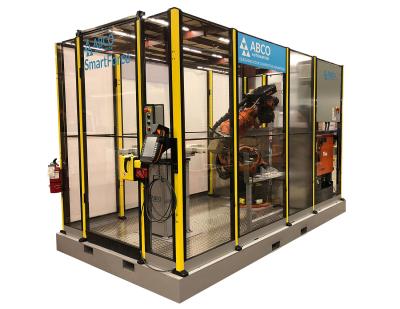
ABCO Automation offers SmartForce, a self-contained turnkey grinding, deburring and polishing robotic cell. Developed in conjunction with 3M, KUKA and PushCorp, SmartForce is a flexible automation solution for manual machining processes.
“We designed and built SmartForce to address the growing need to automate manual grinding, deburring, and polishing,” said Brad Kemmerer, president, ABCO Automation. “Today’s manufacturers recognize that new employees entering the workforce do not want jobs that are gritty, taxing and hazardous. SmartForce offers companies a solution that removes employees from working under those conditions, repositions employees in auxiliary roles, and replaces direct labor with a robot that delivers consistent, quality results.”
With a compact footprint that is less than 100 square feet, SmartForce is mobile and flexible. The robotic cell is pre-engineered and pre-assembled on a metal skid base, which allows manufacturers to not only use it right away but easily move the cell from one section of a facility to another. In addition, other components, such as conveyors and post-processing inspection equipment, can be added to further automate the cell. The cell’s key components include:
- KUKA KR-60 3 F robot
- 3M abrasives
- PushCorp end-of-arm tool
- Safety guarding
- Coolmate coolant system
- Metal skid base
- Dial part infeed table
Kemmerer added: “What makes SmartForce so effective is the combination of PushCorp’s end-of-arm tool with 3M’s abrasive discs. PushCorp’s end-of-arm tool features a toolholder mounted on a force control actively-compliant tool. The tool enables the robot to have human-touch capabilities that can grind, deburr or polish in any orientation, even over contours. The tool’s unique capabilities in conjunction with ABCO programming provides our grinding, deburring and polishing solution its SmartForce.”
Contact Details
Related Glossary Terms
- abrasive
abrasive
Substance used for grinding, honing, lapping, superfinishing and polishing. Examples include garnet, emery, corundum, silicon carbide, cubic boron nitride and diamond in various grit sizes.
- coolant
coolant
Fluid that reduces temperature buildup at the tool/workpiece interface during machining. Normally takes the form of a liquid such as soluble or chemical mixtures (semisynthetic, synthetic) but can be pressurized air or other gas. Because of water’s ability to absorb great quantities of heat, it is widely used as a coolant and vehicle for various cutting compounds, with the water-to-compound ratio varying with the machining task. See cutting fluid; semisynthetic cutting fluid; soluble-oil cutting fluid; synthetic cutting fluid.
- grinding
grinding
Machining operation in which material is removed from the workpiece by a powered abrasive wheel, stone, belt, paste, sheet, compound, slurry, etc. Takes various forms: surface grinding (creates flat and/or squared surfaces); cylindrical grinding (for external cylindrical and tapered shapes, fillets, undercuts, etc.); centerless grinding; chamfering; thread and form grinding; tool and cutter grinding; offhand grinding; lapping and polishing (grinding with extremely fine grits to create ultrasmooth surfaces); honing; and disc grinding.
- polishing
polishing
Abrasive process that improves surface finish and blends contours. Abrasive particles attached to a flexible backing abrade the workpiece.
- toolholder
toolholder
Secures a cutting tool during a machining operation. Basic types include block, cartridge, chuck, collet, fixed, modular, quick-change and rotating.
